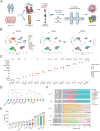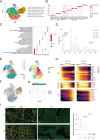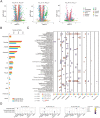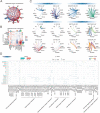Single-cell RNA sequencing in donor and end-stage heart failure patients identifies NLRP3 as a therapeutic target for arrhythmogenic right ventricular cardiomyopathy
- PMID: 38185631
- PMCID: PMC10773142
- DOI: 10.1186/s12916-023-03232-8
Single-cell RNA sequencing in donor and end-stage heart failure patients identifies NLRP3 as a therapeutic target for arrhythmogenic right ventricular cardiomyopathy
Abstract
Background: Dilation may be the first right ventricular change and accelerates the progression of threatening ventricular tachyarrhythmias and heart failure for patients with arrhythmogenic right ventricular cardiomyopathy (ARVC), but the treatment for right ventricular dilation remains limited.
Methods: Single-cell RNA sequencing (scRNA-seq) of blood and biventricular myocardium from 8 study participants was performed, including 6 end-stage heart failure patients with ARVC and 2 normal controls. ScRNA-seq data was then deeply analyzed, including cluster annotation, cellular proportion calculation, and characterization of cellular developmental trajectories and interactions. An integrative analysis of our single-cell data and published genome-wide association study-based data provided insights into the cell-specific contributions to the cardiac arrhythmia phenotype of ARVC. Desmoglein 2 (Dsg2)mut/mut mice were used as the ARVC model to verify the therapeutic effects of pharmacological intervention on identified cellular cluster.
Results: Right ventricle of ARVC was enriched of CCL3+ proinflammatory macrophages and TNMD+ fibroblasts. Fibroblasts were preferentially affected in ARVC and perturbations associated with ARVC overlap with those reside in genetic variants associated with cardiac arrhythmia. Proinflammatory macrophages strongly interact with fibroblast. Pharmacological inhibition of Nod-like receptor protein 3 (NLRP3), a transcriptional factor predominantly expressed by the CCL3+ proinflammatory macrophages and several other myeloid subclusters, could significantly alleviate right ventricular dilation and dysfunction in Dsg2mut/mut mice (an ARVC mouse model).
Conclusions: This study provided a comprehensive analysis of the lineage-specific changes in the blood and myocardium from ARVC patients at a single-cell resolution. Pharmacological inhibition of NLRP3 could prevent right ventricular dilation and dysfunction of mice with ARVC.
Keywords: Arrhythmogenic right ventricular cardiomyopathy; NLRP3; Single-cell RNA sequencing.
© 2023. The Author(s).
Conflict of interest statement
The authors declare that they have no competing interests.
Figures







References
-
- Chen S, Chen L, Saguner AM, Chen K, Akdis D, Gasperetti A, Brunckhorst C, Tang H, Guo G, Rao M, et al. Novel risk prediction model to determine adverse heart failure outcomes in arrhythmogenic right ventricular cardiomyopathy. J Am Heart Assoc. 2022;11(13):e024634. doi: 10.1161/JAHA.121.024634. - DOI - PMC - PubMed
-
- Campuzano O, Alcalde M, Iglesias A, Barahona-Dussault C, Sarquella-Brugada G, Benito B, Arzamendi D, Flores J, Leung TK, Talajic M, et al. Arrhythmogenic right ventricular cardiomyopathy: severe structural alterations are associated with inflammation. J Clin Pathol. 2012;65(12):1077–1083. doi: 10.1136/jclinpath-2012-201022. - DOI - PubMed
Publication types
MeSH terms
Substances
Grants and funding
LinkOut - more resources
Full Text Sources
Medical
Miscellaneous

